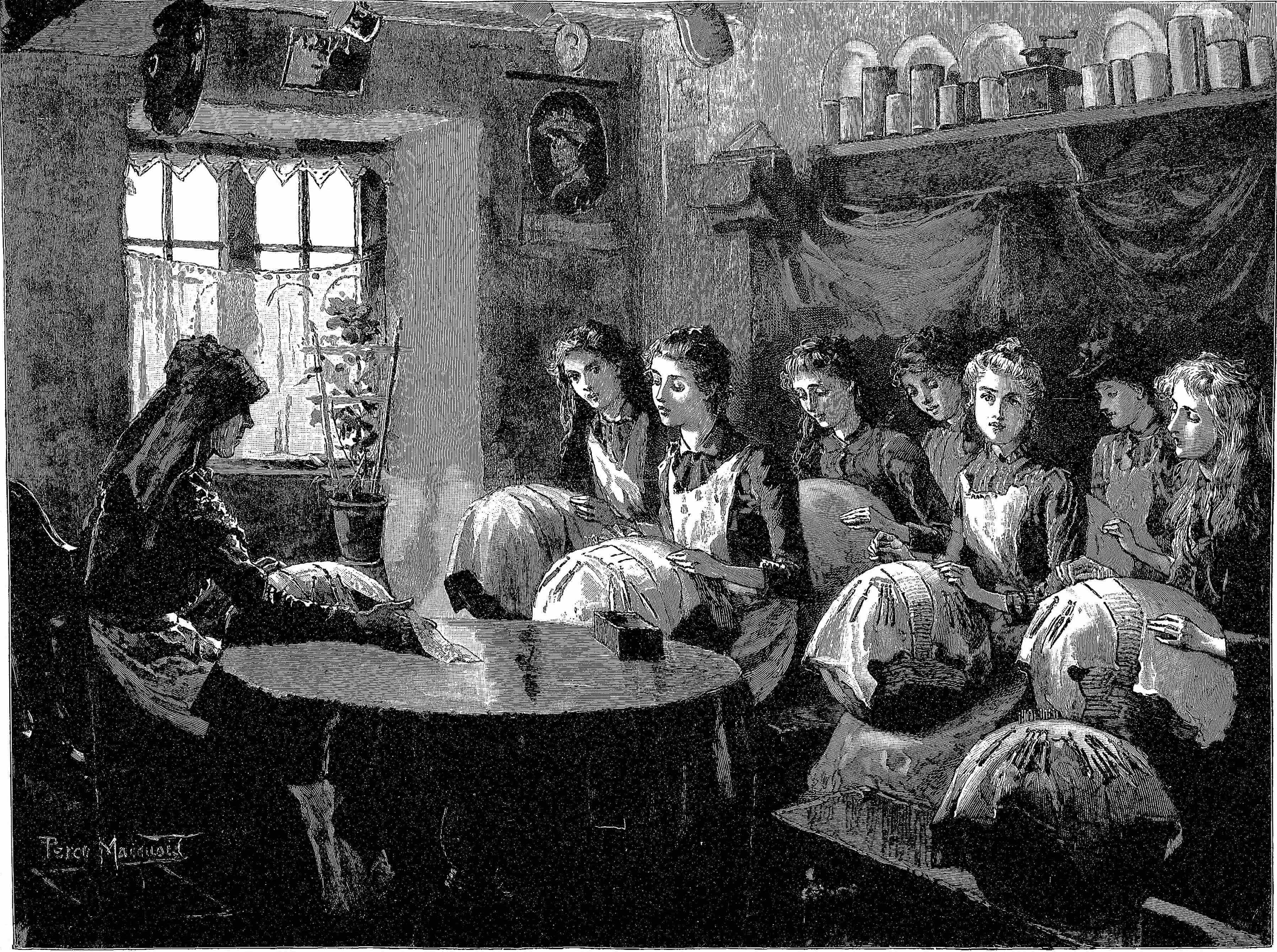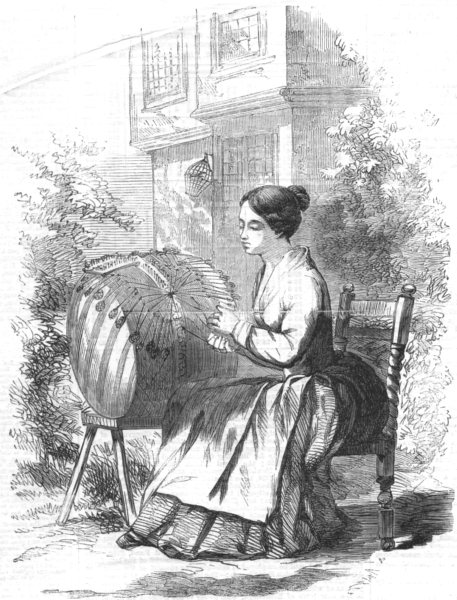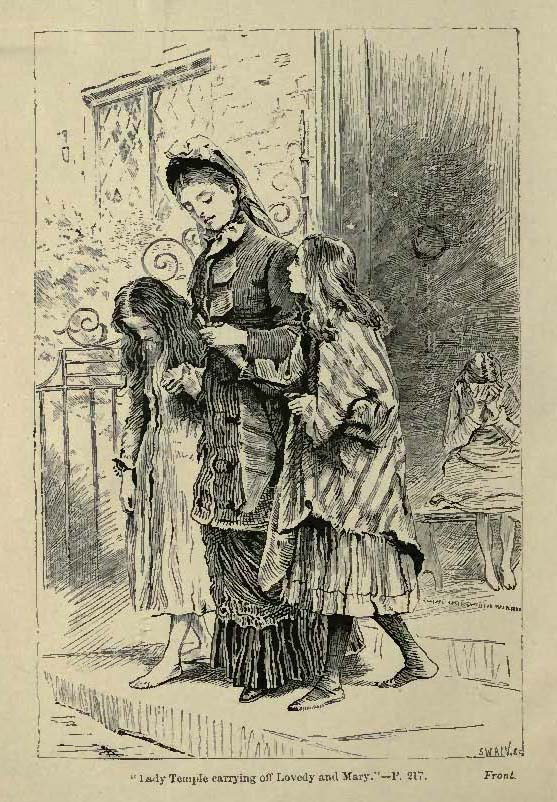In her Victorian heyday Charlotte Mary Yonge (1823-1901) was as popular and as prolific a novelist as Dickens and Trollope. She has fallen out of fashion somewhat since, despite the efforts of the excellent Charlotte Mary Yonge Fellowship, whose website we recommend. Although a witty and lively writer, especially of dialogue, it was Yonge’s social and religious opinions which drove her plots, and explain why they feel so dated. This can be illustrated by the example of The Clever Woman of the Family, but our reason for including it in this series of blogs on lacemakers in fiction is because it also offers a picture of the Devon lace industry in the high Victorian period.

Charlotte Mary Yonge, by George Richmond, 1844.
Yonge’s novel opens in the early 1860s on Rachel Curtis’s twenty-fifth birthday. She is the daughter of a gentry family in the fictional Devon fishing and resort village of Avonmouth and, in her own opinion at least, the clever woman of the family. But she can find no outlet for her intelligence and her energies because she is “tethered down to the merest mockery of usefulness by conventionalities. I am a young lady forsooth! — I must not be out late; I must not put forth my views; I must not choose my acquaintance; I must be a mere helpless, useless being, growing old in a ridiculous fiction of prolonged childhood”.
The primary objects of Rachel’s desire to be useful are the “hard worked, half-stifled little girls” in the local lace schools: “cramped in soul, destroyed in body, that fine ladies may wear lace trimmings”. It galls her that a charitable bequest by one of her ancestors in the seventeenth century actually pays for the girls’ apprenticeships. At the moment the only support she is able to provide is by purchasing their products, even though she describes lace as “cobwebs of vanity” (while her mother detests “that black lace thing, that looks fit for your grandmother” which she is obliged to wear as a consequence of her philanthropic consumption) and reading to the lacemakers in their schoolroom. This location is a “black-hole under the stairs” without windows where the local lace mistress keeps seven children in rigid silence for ten hours a day. Rachel reads them something religious, something improving, and a bit of a story, alongside mental arithmetic which, according to the author “was about as interesting as the humming of a blue-bottle fly” to its “well-broken” denizens. The idea that one must be “broken to lace” recurs throughout the book.
Rachel is particularly exercised by the fate of one intelligent girl, Lovedy Kelland, whose mother had refused to sacrifice her little girl “to the Moloch of lace” but instead sent her to school. There were even hopes she might become a trainee teacher. But when her mother dies, the girl is adopted by the lace-mistress “with the resolve to act the truly kind part by her, and break her in to lace-making.” But while Rachel is infuriated by Lovedy’s fate, her real ambition is to attack “the system… that chained girls to an unhealthy occupation in their early childhood, and made an overstocked market and underpaid workers”. “Lace and lacemakers are facts,” she explains to her distracted cousin Fanny, “but if the middle-men were exploded, and the excess of workers drafted off by some wholesome outlet, the price would rise, so that the remainder would be at leisure to fulfil the domestic offices of womanhood.” However, her wealthy neighbours have no desire push up the price of lace, and the lacemakers themselves are drawn to Primitive Methodism to escape the well-meaning interference of local do-gooders; they only tolerate Rachel because of her family’s historic position in the community.
Her opportunity to act comes through a chance encounter with Mr Mauleverer, a philanthropic lecturer and, it is implied but never quite established as fact, a clergyman unable to find a position because of his modern “opinions”. With his encouragement she launches the Female Union for Lacemaker’s Employment (the initials are not inconsequential, and the name is later changed to the Female Union for Englishwoman’s Employment or F.U.E.E.), gathering funds from near and far to support an Industrial School for the former lacemakers where, as Rachel explains “some fresh trades might be taught, so as to lessen the glut of the market, and to remove the workers that are forced to undersell one another, and thus oblige the buyers to give a fairly remunerative price.” A magazine is launched under the banner “Am I not a Sister?” (a reference to the famous slogan of the slave emancipation movement at the turn of the century, “Am I not a Man and a Brother?” For another novelist who drew connections between lacemaking and slavery, see our post on Johanna Courtmans-Berchmans). Premises are found nearby, a matron employed, and two lacemakers, including Lovedy Kelland, are taken in with the promise of becoming wood-engravers.
Sadly, Mauleverer turns out to be a con-man who pockets the monies raised by Rachel, while the matron is a vicious tyrant who starves the girls while forcing them to make sprigs day and night, beating them with a stick if they failed to fulfil their quota. The deception comes to light when Mauleverer presents two woodcuts, which he claims were engraved by the F.U.E.E’s trainees, jointly entitled “The free maids that weave their thread with bones” (the Shakespearean description of lacemakers). One woodcut, depicting a pretty maiden outside a cottage door with roses, honeysuckles and other “conventional rural delights” is labelled “Ideal”; the other, showing “a den of thin, wizened, half-starved girls, cramped over their cushions in a lace-school” is labelled “Real”. Rachel’s friends prove to her that in fact both images had been snipped out of an old copy of the London Illustrated News. However, this revelation comes too late for the beaten, emaciated Lovedy who dies of diphtheria soon after her release. Her last words to Rachel as watches over her deathbed are “Please tell me of my Saviour”, but Rachel finds she cannot, so far has she drifted from the verities of the established Church. (On the whole the poor in Yonge’s novels do not provide moral lessons to the rich, as they do in Charlotte Barnard’s work: this scene is an exception.) Lovedy’s death is only one of several shocks to Rachel’s image of herself as “the clever woman of the family”, but it is the most brutal.
Before the end of the novel Rachel will learn that only by submitting herself to patriarchal authority can she fulfil her life’s purpose. Male superiority appears first in the shape of her husband, but he is but a stepping stone to the masculine font of all authority, the Church. She will discover that the social conventions against which she railed at the beginning were instituted for her well-being, and even her fashion sense must be submitted to her husband (who has as low an opinion of her charitable lace purchases as her mother). In the second half of the novel the sufferings of the poor are largely forgotten and in as much as Rachel still feels that “every alley and lane of town or country reeks with vice and corruption”, the implicit argument of the novel is that not much could or should be done about it, or at least not by women alone uninstructed by pious men. After all, as Rachel explains at the end, one never knows whether one is doing more harm than good. “I had a few intellectual tastes, and liked to think and read, which was supposed to be cleverness; and my wilfulness made me fancy myself superior in force of character in a way I could never have imagined if I had lived more in the world. Contact with really clever people has shown me that I am slow and unready.”

“Lady Temple carrying off Lovedy and Mary”. Adrian Stokes’ illustration from the 1880 edition of The Clever Woman of the Family depicts the moment when Rachel’s cousin intervenes to rescue two girls from “the Moloch of lace”.
Yonge sincerely believed in male superiority, and for many years opposed developments in women’s education. This is surely one reason that her works have fallen out of fashion. She was a tireless proselytizer for the Church of England in its most High Church, Oxford Movement garb. Although her characters are more rounded than Barnard’s and More’s ciphers, the moral message of her work is hammered home in chapter titles and epigrams. But perhaps even more off-putting is her absolute acceptance not just of social inequality — even for the exemplar of modern intellectual trends Rachel Curtis, class hierarchy is a given — but also social conventions. This is a novel in which the characters can spend the best part of the chapter discussing whether it is appropriate for a young widow to play croquet. Although in the text the partisans for the game carry the day, the author reveals her own allegiances when later the initiator of the craze in Avonmouth, a fashionable but wilful and selfish young woman, is killed in a freak croquet accident.
Lace-making is a background theme of the novel – the motor of Rachel’s enlightenment rather than a topic in itself, and it fades out completely in the second half of the book. Nonetheless it is clear that Yonge knew something of the trade. Her family came from Devon and she often holidayed there. She was certainly familiar with the vocabulary of the Honiton lace industry, such as “sprigs” for the patterns made by the lacemakers, and “gapsies” for the illicit breaks observed in the lace school. But if some knowledge came from direct observation, it is likely that she had also read the report of Commissioner John Edmund White on the lace industry (1864) as part of the Royal Commission on the Employment of Children and Young Persons in Trades and Manufactures not already Regulated by Law. White confirms, for example, the importance of the apprenticeships to lace mistresses in Devon (compared with the Midlands). Apprentices would be trained for a year and half or so before they could start making money on their own account. Yonge’s description of a lace school is also similar to those visited by White. For instance, Mrs Besley’s lace school at Seaton was an annexe to her cottage, “nearly square, a little over seven feet each way, and six feet six inches high, and containing, in fact, a little over 330 cubic feet, and there is no fireplace or means of warming”. This tiny space was shared by seven pupils, the mistress and her three daughters, working from early morning till at least 10:00pm, and often much later or even all through the night. As another lace mistress, Mrs Croydon, put it, “If you promise the work, you must do it” regardless of what strain it caused the young girls. Yonge’s Mrs Kelland would doubtless have agreed.
Girls started in these lace schools as young as four or five, though they were normally not expected to do a full day’s (and night’s) work until aged seven. Work would start at six or seven in the morning, and those mistresses like Mrs Copp of Beer who closed at ten in the evening, summer and winter, obviously considered themselves philanthropic for not keeping the girls later. The term school is something of a misnomer as most appear to have provided no education beyond lace skills. Hence the effort that Rachel Curtis puts into night schools and Sunday schools, where lacemakers might learn their letters, even though she felt that such efforts were only “scratching the surface”. Commissioner White was shocked by the levels of ignorance he encountered: for example, thirteen-year-old Emily Westlake, whom he interviewed at Mrs Besley’s school, “Knows the letters (and no more), but no figures (when shown) except ‘1’.” Yonge highlights this mental cramping in the character of Susan Kelland, daughter of the lace-mistress, “who was supposed to be a sort of spider, with no capacities beyond her web.” White highlighted the deleterious health effects of such children “crumped up” (to use the local term) over pillows in such ill-ventilated, stuffy rooms, alternatively too cold or too hot, for hours on end. The girls suffered from headaches, they damaged their eyes, and in some cases even died of brain fever from over-taxation. All this to earn between a shilling and, at most, even for the most adept, three shillings six pence a week (by way of comparison, in this region of very depressed wages, a male agricultural labourer might earn eight shillings a week on average).
The description of the lacemakers’ sufferings at the hands of the F.U.E.E.’s matron Mrs Rawlins –beaten, forced to work through the night, and in effect starved to death – also recalls accounts of the Barratt case of 1856, which Yonge may have read; it was certainly covered in her local newspaper. Like the Barratt’s sister and parents, Mrs Rawlins would be tried for manslaughter at the assizes, and in her case sentenced to one year’s hard labour.

Charlotte Mary Yonge, c. 1860. Copyright: National Portrait Gallery
Yonge is sniffy about Rachel Curtis’s desire to reform the system (“everything was a system with Rachel”) rather than, at most, relieve the symptoms of poverty (a much more proper activity for upper-class women). However, The Royal Commission’s report made it obvious that manufacturing’s reliance on child labour could not be ameliorated by private charity alone, it could only be addressed through legislation. Its first fruit was the Workshop Act of 1867, which stated that no child under eight could be employed, that children between eight and thirteen could work no more than six hours a day, and all employed children should get ten hours of formal schooling a week. Further regulation of workshops, together with new educational requirements, would effectively kill off the lace schools over the next two decades.
Further Reading
British Parliamentary Papers, House of Commons, First Report of the Commissioners on the Employment of Children and Young Persons in Trades and Manufactures not already Regulated by Law. 1863. As far as lace manufacturing is concerned, the findings of the Commission are usefully summarized in a more accessible pamphlet: Alan Brown, Take the Children: How Victorian Lace Girls Lived and Worked in the Honiton and East Midlands Districts — This is their Story, as Told to the 1862 Royal Commission (Sawbridgeworth, c. 2000).
Janice Fiamengo, “Forms of Suffering in Charlotte Yonge’s The Clever Woman of the Family”, Victorian Review 25:2 (2000); 85-105.
H.J. Yallop, The History of the Honiton Lace Industry (University of Exeter Press, 1992).














